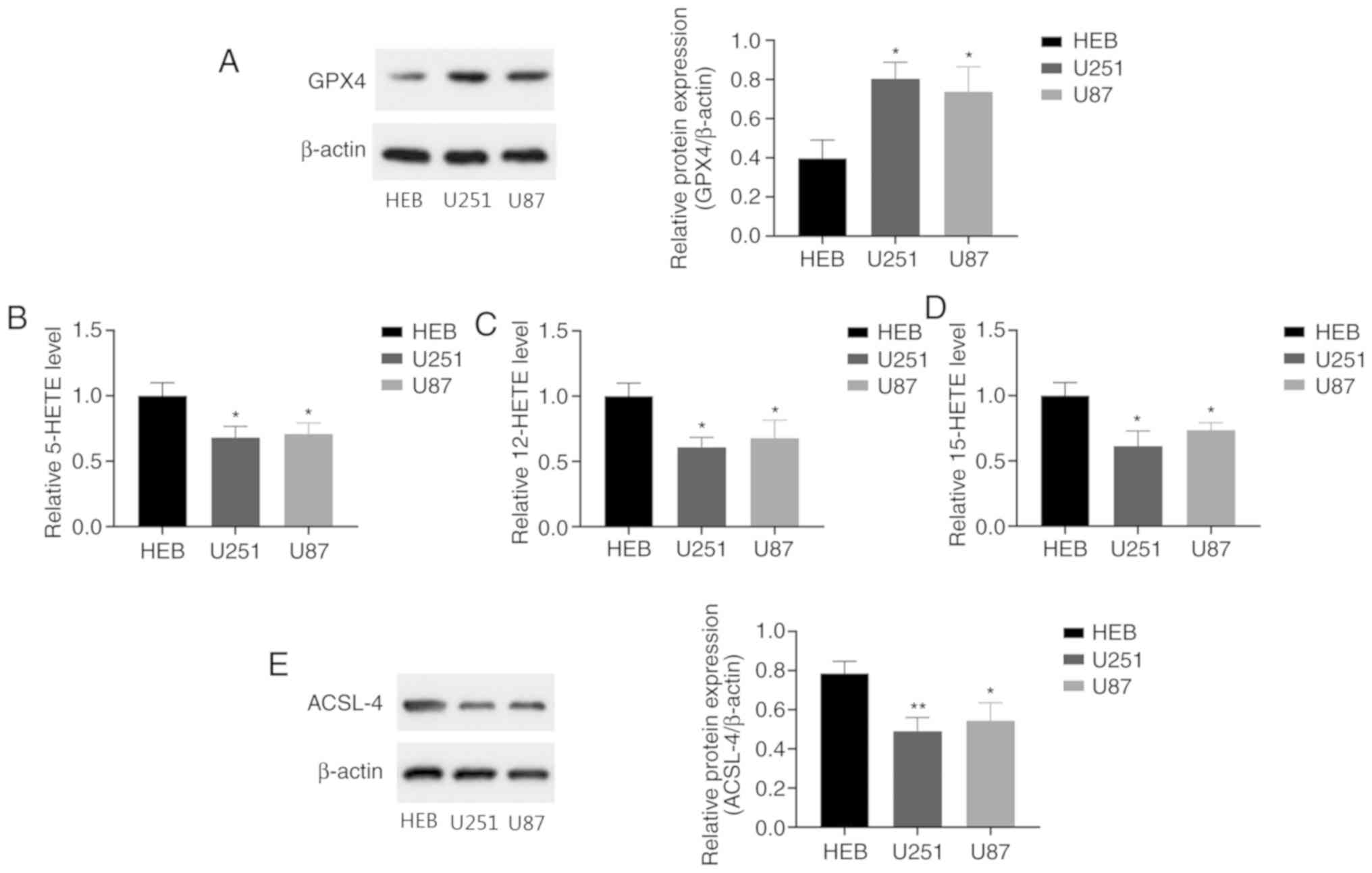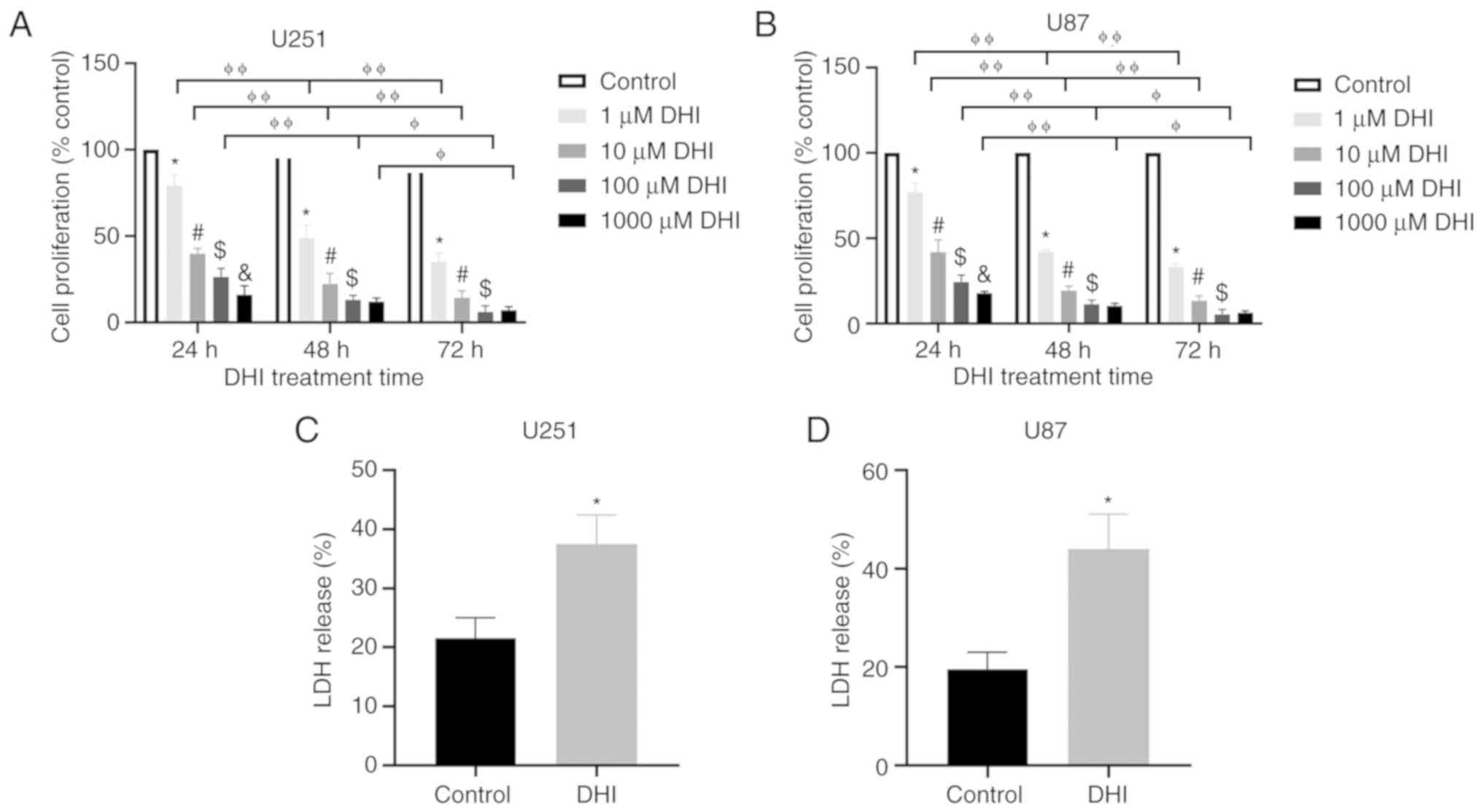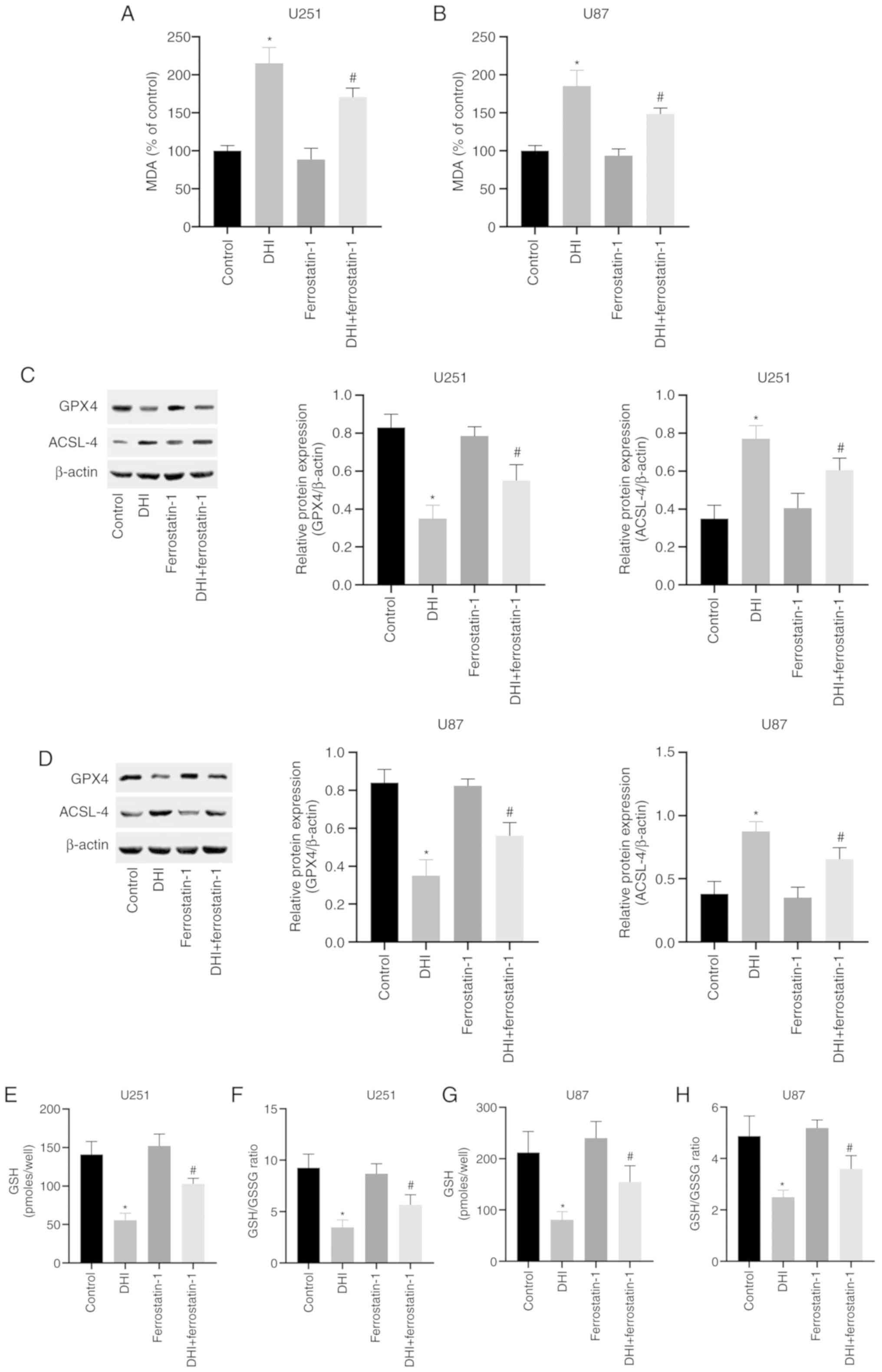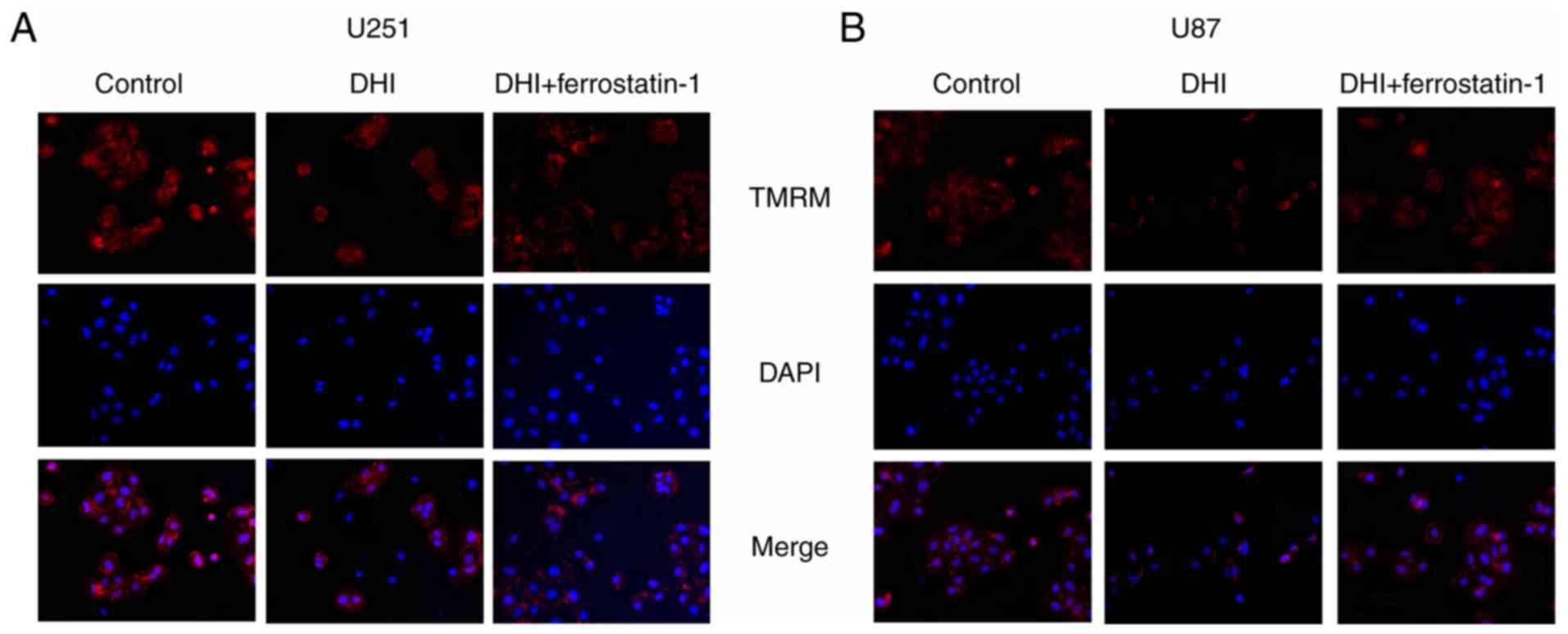|
1
|
Ohtaki S, Wanibuchi M, Kataoka-Sasaki Y,
Sasaki M, Oka S, Noshiro S, Akiyama Y, Mikami T, Mikuni N, Kocsis
JD and Honmou O: ACTC1 as an invasion and prognosis marker in
glioma. J Neurosurg. 126:467–475. 2017. View Article : Google Scholar : PubMed/NCBI
|
|
2
|
Ohgaki H and Kleihues P: Population-based
studies on incidence, survival rates, and genetic alterations in
astrocytic and oligodendroglial gliomas. J Neuropathol Exp Neurol.
64:479–489. 2005. View Article : Google Scholar : PubMed/NCBI
|
|
3
|
Hadjipanayis CG and Van Meir EG: Tumor
initiating cells in malignant gliomas: Biology and implications for
therapy. J Mol Med (Berl). 87:363–374. 2009. View Article : Google Scholar : PubMed/NCBI
|
|
4
|
Becker D, Scherer M, Neher P, Jungk C,
Jesser J, Pflüger I, Brinster R, Bendszus M, Bruckner T, Maier-Hein
K and Unterberg A: Going beyond Diffusion Tensor Imaging
tractography in eloquent glioma surgery-high resolution fiber
tractography: Q-ball or constrained spherical deconvolution? World
Neurosurg. 134:e596–e609. 2020. View Article : Google Scholar : PubMed/NCBI
|
|
5
|
Cajigas I, Mahavadi AK, Shah AH, Borowy V,
Abitbol N, Ivan ME, Komotar RJ and Epstein RH: Analysis of
intra-operative variables as predictors of 30-day readmission in
patients undergoing glioma surgery at a single center. J
Neurooncol. 145:509–518. 2019. View Article : Google Scholar : PubMed/NCBI
|
|
6
|
Slof J, Diez Valle R and Galvan J:
Cost-effectiveness of 5-aminolevulinic acid-induced fluorescence in
malignant glioma surgery. Neurologia. 30:163–168. 2015.(In En,
Spanish). View Article : Google Scholar : PubMed/NCBI
|
|
7
|
Brokinkel B, Yavuz M, Warneke N, Brentrup
A, Hess K, Bleimüller C, Wölfer J and Stummer W: Endoscopic
management of a low-grade thalamic glioma: A safe alternative to
open microsurgery? Acta Neurochir (Wien). 159:1237–1240. 2017.
View Article : Google Scholar : PubMed/NCBI
|
|
8
|
Maruyama A, Yasuoka S, Katoh N and Asai J:
Radiation-induced osteosarcoma of the skull mimicking cutaneous
tumor after treatment for frontal glioma. J Dermatol. 47:69–71.
2020. View Article : Google Scholar : PubMed/NCBI
|
|
9
|
Siva S, Kothari G, Muacevic A, Louie AV,
Slotman BJ, The BS and Lo SS: Radiotherapy for renal cell
carcinoma: Renaissance of an overlooked approach. Nat Rev Urol.
14:549–563. 2017. View Article : Google Scholar : PubMed/NCBI
|
|
10
|
Milosevic M, Gospodarowicz M, Zietman A,
Abbas F, Haustermans K, Moonen L, Rödel C, Schoenberg M and Shipley
W: Radiotherapy for bladder cancer. Urology. 69 (1 Suppl):S80–S92.
2007. View Article : Google Scholar
|
|
11
|
Bitterman DS, MacDonald SM, Yock TI,
Tarbell NJ, Wright KD, Chi SN, Marcus KJ and Haas-Kogan DA:
Revisiting the role of radiation therapy for pediatric low-grade
glioma. J Clin Oncol. 37:3335–3339. 2019. View Article : Google Scholar : PubMed/NCBI
|
|
12
|
Lu VM, Welby JP, Laack NN, Mahajan A and
Daniels DJ: Pseudoprogression after radiation therapies for low
grade glioma in children and adults: A systematic review and
meta-analysis. Radiother Oncol. 142:36–42. 2020. View Article : Google Scholar : PubMed/NCBI
|
|
13
|
Kieran MW, Goumnerova L, Manley P, Chi SN,
Marcus KJ, Manzanera AG, Silva Polanco ML, Guzik BW,
Aguilar-Cordova E, Diaz-Montero CM, et al: Phase I study of
gene-mediated cytotoxic immunotherapy with AdV-tk as adjuvant to
surgery and radiation for pediatric malignant glioma and recurrent
ependymoma. Neuro Oncol. 21:537–546. 2019. View Article : Google Scholar : PubMed/NCBI
|
|
14
|
Wang X, Morris-Natschke SL and Lee KH: New
developments in the chemistry and biology of the bioactive
constituents of Tanshen. Med Res Rev. 27:133–148. 2007. View Article : Google Scholar : PubMed/NCBI
|
|
15
|
Tzen JT, Jinn TR, Chen YC, Li FY, Cheng
FC, Shi LS, She HK, Chen BC, Hsieh V and Tu ML: Magnesium
lithospermate B possesses inhibitory activity on Na+,K+-ATPase and
neuroprotective effects against ischemic stroke. Acta Pharmacol
Sin. 28:609–615. 2007. View Article : Google Scholar : PubMed/NCBI
|
|
16
|
Lee DS and Lee SH: Biological activity of
dihydrotanshinone I: Effect on apoptosis. J Biosci Bioeng.
89:292–293. 2000. View Article : Google Scholar : PubMed/NCBI
|
|
17
|
Tsai SL, Suk FM, Wang CI, Liu DZ, Hou WC,
Lin PJ, Hung LF and Liang YC: Anti-tumor potential of
15,16-dihydrotanshinone I against breast adenocarcinoma through
inducing G1 arrest and apoptosis. Biochem Pharmacol. 74:1575–1586.
2007. View Article : Google Scholar : PubMed/NCBI
|
|
18
|
Wang L, Hu T, Shen J, Zhang L, Chan RLY,
Lu L, Li M, Cho CH and Wu WKK: Dihydrotanshinone I induced
apoptosis and autophagy through caspase dependent pathway in colon
cancer. Phytomedicine. 22:1079–1087. 2015. View Article : Google Scholar : PubMed/NCBI
|
|
19
|
Cheng R, Chen J, Wang Y, Ge Y, Huang Z and
Zhang G: Dihydrotanshinone induces apoptosis of SGC7901 and MGC803
cells via activation of JNK and p38 signalling pathways. Pharm
Biol. 54:3019–3025. 2016. View Article : Google Scholar : PubMed/NCBI
|
|
20
|
Cheng J, Fan YQ, Liu BH, Zhou H, Wang JM
and Chen QX: ACSL4 suppresses glioma cells proliferation via
activating ferroptosis. Oncol Rep. 43:147–158. 2020.PubMed/NCBI
|
|
21
|
Houessinon A, Francois C, Sauzay C,
Louandre C, Mongelard G, Godin C, Bodeau S, Takahashi S, Saidak Z,
Gutierrez L, et al: Metallothionein-1 as a biomarker of altered
redox metabolism in hepatocellular carcinoma cells exposed to
sorafenib. Mol Cancer. 15:382016. View Article : Google Scholar : PubMed/NCBI
|
|
22
|
Ooko E, Saeed ME, Kadioglu O, Sarvi S,
Colak M, Elmasaoudi K, Janah R, Greten HJ and Efferth T:
Artemisinin derivatives induce iron-dependent cell death
(ferroptosis) in tumor cells. Phytomedicine. 22:1045–1054. 2015.
View Article : Google Scholar : PubMed/NCBI
|
|
23
|
Dixon SJ, Lemberg KM, Lamprecht MR, Skouta
R, Zaitsev EM, Gleason CE, Patel DN, Bauer AJ, Cantley AM, Yang WS,
et al: Ferroptosis: An iron-dependent form of nonapoptotic cell
death. Cell. 149:1060–1072. 2012. View Article : Google Scholar : PubMed/NCBI
|
|
24
|
Xie Y, Hou W, Song X, Yu Y, Huang J, Sun
X, Kang R and Tang D: Ferroptosis: Process and function. Cell Death
Differ. 23:369–379. 2016. View Article : Google Scholar : PubMed/NCBI
|
|
25
|
Dixon SJ and Stockwell BR: The role of
iron and reactive oxygen species in cell death. Nat Chem Biol.
10:9–17. 2014. View Article : Google Scholar : PubMed/NCBI
|
|
26
|
Stockwell BR, Friedmann Angeli JP, Bayir
H, Bush AI, Conrad M, Dixon SJ, Fulda S, Gascón S, Hatzios SK,
Kagan VE, et al: Ferroptosis: A regulated cell death nexus linking
metabolism, redox biology, and disease. Cell. 171:273–285. 2017.
View Article : Google Scholar : PubMed/NCBI
|
|
27
|
Lu B, Chen XB, Ying MD, He QJ, Cao J and
Yang B: The role of ferroptosis in cancer development and treatment
response. Front Pharmacol. 8:9922018. View Article : Google Scholar : PubMed/NCBI
|
|
28
|
Wenzel SE, Tyurina YY, Zhao J, St Croix
CM, Dar HH, Mao G, Tyurin VA, Anthonymuthu TS, Kapralov AA,
Amoscato AA, et al: PEBP1 wardens ferroptosis by enabling
lipoxygenase generation of lipid death signals. Cell. 171:628–641.
2017. View Article : Google Scholar : PubMed/NCBI
|
|
29
|
Doll S, Proneth B, Tyurina YY, Panzilius
E, Kobayashi S, Ingold I, Irmler M, Beckers J, Aichler M, Walch A,
et al: ACSL4 dictates ferroptosis sensitivity by shaping cellular
lipid composition. Nat Chem Biol. 13:91–98. 2017. View Article : Google Scholar : PubMed/NCBI
|
|
30
|
Sun X, Ou Z, Chen R, Niu X, Chen D, Kang R
and Tang D: Activation of the p62-Keap1-NRF2 pathway protects
against ferroptosis in hepatocellular carcinoma cells. Hepatology.
63:173–184. 2016. View Article : Google Scholar : PubMed/NCBI
|
|
31
|
Lin YS, Shen YC, Wu CY, Tsai YY, Yang YH,
Lin YY, Kuan FC, Lu CN, Chang GH, Tsai MS, et al: Danshen improves
survival of patients with breast cancer and dihydroisotanshinone I
induces ferroptosis and apoptosis of breast cancer cells. Front
Pharmacol. 10:12262019. View Article : Google Scholar : PubMed/NCBI
|
|
32
|
Parhamifar L, Andersen H and Moghimi SM:
Lactate dehydrogenase assay for assessment of polycation
cytotoxicity. Methods Mol Biol. 1943:291–299. 2019. View Article : Google Scholar : PubMed/NCBI
|
|
33
|
Shan Y, Liu B, Li L, Chang N, Li L, Wang
H, Wang D, Feng H, Cheung C, Liao M, et al: Regulation of PINK1 by
NR2B-containing NMDA receptors in ischemic neuronal injury. J
Neurochem. 111:1149–1160. 2009. View Article : Google Scholar : PubMed/NCBI
|
|
34
|
Baysal M, Ilgin S, Kilic G, Kilic V,
Ucarcan S and Atli O: Reproductive toxicity after levetiracetam
administration in male rats: Evidence for role of hormonal status
and oxidative stress. PLoS One. 12:e1759902017. View Article : Google Scholar
|
|
35
|
Imai H, Matsuoka M, Kumagai T, Sakamoto T
and Koumura T: Lipid peroxidation-dependent cell death regulated by
GPx4 and ferroptosis. Curr Top Microbiol Immunol. 403:143–170.
2017.PubMed/NCBI
|
|
36
|
Li C, Deng X, Zhang W, Xie X, Conrad M,
Liu Y, Angeli JPF and Lai L: Novel allosteric activators for
ferroptosis regulator glutathione peroxidase 4. J Med Chem.
62:266–275. 2019. View Article : Google Scholar : PubMed/NCBI
|
|
37
|
Yuan H, Li X, Zhang X, Kang R and Tang D:
Identification of ACSL4 as a biomarker and contributor of
ferroptosis. Biochem Biophys Res Commun. 478:1338–1343. 2016.
View Article : Google Scholar : PubMed/NCBI
|
|
38
|
Yang WS and Stockwell BR: Ferroptosis:
Death by lipid peroxidation. Trends Cell Biol. 26:165–176. 2016.
View Article : Google Scholar : PubMed/NCBI
|
|
39
|
Zhou Y: The protective effects of
cryptochlorogenic acid on β-cells function in diabetes in vivo and
vitro via inhibition of ferroptosis. Diabetes Metab Syndr Obes.
13:1921–1931. 2020. View Article : Google Scholar : PubMed/NCBI
|
|
40
|
Friedmann Angeli AJ, Schneider M, Proneth
B, Tyurina YY, Tyurin VA, Hammond VJ, Herbach N, Aichler M, Walch
A, Eggenhofer E, et al: Inactivation of the ferroptosis regulator
Gpx4 triggers acute renal failure in mice. Nat Cell Biol.
16:1180–1191. 2014. View Article : Google Scholar
|
|
41
|
Zilka O, Shah R, Li B, Friedmann Angeli
JP, Griesser M, Conrad M and Pratt DA: On the mechanism of
cytoprotection by ferrostatin-1 and liproxstatin-1 and the role of
lipid peroxidation in ferroptotic cell death. ACS Cent Sci.
3:232–243. 2017. View Article : Google Scholar : PubMed/NCBI
|
|
42
|
Wang L, Ma R, Liu C, Liu H, Zhu R, Guo S,
Tang M, Li Y, Niu J, Fu M, et al: Salvia miltiorrhiza: A potential
red light to the development of cardiovascular diseases. Curr Pharm
Des. 23:1077–1097. 2017. View Article : Google Scholar : PubMed/NCBI
|
|
43
|
Xu Y, Chen T, Li X, Qu YK, An JN, Zheng
HX, Zhang ZJ and Lin N: Salvia miltiorrhiza bunge increases
estrogen level without side effects on reproductive tissues in
immature/ovariectomized mice. Aging (Albany NY). 9:156–172. 2016.
View Article : Google Scholar : PubMed/NCBI
|
|
44
|
Zhang PR and Lü Q: A study on anticancer
activity of tanshinone II A against human breast cancer. Sichuan Da
Xue Xue Bao Yi Xue Ban. 40:245–249. 2009.(In Chinese). PubMed/NCBI
|
|
45
|
Zhang HS, Zhang FJ, Li H, Liu Y, Du GY and
Huang YH: Tanshinone A inhibits human esophageal cancer cell growth
through miR-122-mediated PKM2 down-regulation. Arch Biochem
Biophys. 598:50–56. 2016. View Article : Google Scholar : PubMed/NCBI
|
|
46
|
Liu D, Yuan R, Yang F and Zhang D: Effects
of tanshinones mediated by forkhead box O3a transcription factor on
the proliferation and apoptosis of lung cancer cells. Oncol Lett.
17:450–455. 2019.PubMed/NCBI
|
|
47
|
Mosaddik MA: In vitro cytotoxicity of
tanshinones isolated from Salvia miltiorrhiza Bunge against P388
lymphocytic leukemia cells. Phytomedicine. 10:682–685. 2003.
View Article : Google Scholar : PubMed/NCBI
|
|
48
|
Park JW, Lee SH, Yang MK, Lee JJ, Song MJ,
Ryu SY, Chung HJ, Won HS, Lee CS, Kwon SH, et al:
15,16-dihydrotanshinone I, a major component from Salvia
miltiorrhiza Bunge (Dansham), inhibits rabbit platelet aggregation
by suppressing intracellular calcium mobilization. Arch Pharm Res.
31:47–53. 2008. View Article : Google Scholar : PubMed/NCBI
|
|
49
|
Suk FM, Jou WJ, Lin RJ, Lin SY, Tzeng FY
and Liang YC: 15,16-Dihydrotanshinone I-induced apoptosis in human
colorectal cancer cells: Involvement of ATF3. Anticancer Res.
33:3225–3231. 2013.PubMed/NCBI
|
|
50
|
Wu CY, Yang YH, Lin YY, Kuan FC, Lin YS,
Lin WY, Tsai MY, Yang JJ, Cheng YC, Shu LH, et al: Anti-cancer
effect of danshen and dihydroisotanshinone I on prostate cancer:
Targeting the crosstalk between macrophages and cancer cells via
inhibition of the STAT3/CCL2 signaling pathway. Oncotarget.
8:40246–40263. 2017. View Article : Google Scholar : PubMed/NCBI
|
|
51
|
Lin YY, Lee IY, Huang WS, Lin YS, Kuan FC,
Shu LH, Cheng YC, Yang YH and Wu CY: Corrigendum to ‘Danshen
improves survival of patients with colon cancer and
dihydroisotanshinone I inhibit the proliferation of colon cancer
cells via apoptosis and skp2 signaling pathway’. J Ethnopharmacol.
213:4462018. View Article : Google Scholar : PubMed/NCBI
|
|
52
|
Ju LX, Chen Z and Ren RZ: Progress in
research on the treatment of primary liver cancer with traditional
Chinese medicine for activating blood to resolve stasis. Zhong Xi
Yi Jie He Xue Bao. 3:491–494. 2005.(In Chinese). View Article : Google Scholar : PubMed/NCBI
|
|
53
|
Aquilanti E, Miller J, Santagata S, Cahill
DP and Brastianos PK: Updates in prognostic markers for gliomas.
Neuro Oncol. 20 (Suppl 7):vii17–vii26. 2018. View Article : Google Scholar : PubMed/NCBI
|
|
54
|
Mair DB, Ames HM and Li R: Mechanisms of
invasion and motility of high-grade gliomas in the brain. Mol Biol
Cell. 29:2509–2515. 2018. View Article : Google Scholar : PubMed/NCBI
|
|
55
|
Hanaei S, Afshari K, Hirbod-Mobarakeh A,
Mohajer B, Amir DD and Rezaei N: Therapeutic efficacy of specific
immunotherapy for glioma: A systematic review and meta-analysis.
Rev Neurosci. 29:443–461. 2018. View Article : Google Scholar : PubMed/NCBI
|
|
56
|
Natsume A and Yoshida J: Gene therapy for
high-grade glioma: Current approaches and future directions. Cell
Adh Migr. 2:186–191. 2008. View Article : Google Scholar : PubMed/NCBI
|
|
57
|
Latunde-Dada GO: Ferroptosis: Role of
lipid peroxidation, iron and ferritinophagy. Biochim Biophys Acta
Gen Subj. 1861:1893–1900. 2017. View Article : Google Scholar : PubMed/NCBI
|
|
58
|
Zhang L, Liu W, Liu F, Wang Q, Song M, Yu
Q, Tang K, Teng T, Wu D, Wang X, et al: IMCA Induces ferroptosis
mediated by SLC7A11 through the AMPK/mTOR pathway in colorectal
cancer. Oxid Med Cell Longev. 2020:16756132020. View Article : Google Scholar : PubMed/NCBI
|
|
59
|
Homma T and Fujii J: Application of
glutathione as anti-oxidative and anti-aging drugs. Curr Drug
Metab. 16:560–571. 2015. View Article : Google Scholar : PubMed/NCBI
|
|
60
|
Wang Y, Zhao Y, Wang H, Zhang C, Wang M,
Yang Y, Xu X and Hu Z: Histone demethylase KDM3B protects against
ferroptosis by upregulating SLC7A11. FEBS Open Bio. 10:637–643.
2020. View Article : Google Scholar : PubMed/NCBI
|
|
61
|
Kim DH, Kim WD, Kim SK, Moon DH and Lee
SJ: TGF-β1-mediated repression of SLC7A11 drives vulnerability to
GPX4 inhibition in hepatocellular carcinoma cells. Cell Death Dis.
11:4062020. View Article : Google Scholar : PubMed/NCBI
|
|
62
|
Friedmann AJ and Conrad M: Selenium and
GPX4, a vital symbiosis. Free Radic Biol Med. 127:153–159. 2018.
View Article : Google Scholar : PubMed/NCBI
|
|
63
|
Ingold I, Berndt C, Schmitt S, Doll S,
Poschmann G, Buday K, Roveri A, Peng X, Freitas FP, Seibt T, et al:
Selenium utilization by GPX4 is required to prevent
hydroperoxide-induced ferroptosis. Cell. 172:409–422.e21. 2018.
View Article : Google Scholar : PubMed/NCBI
|
|
64
|
Sui X, Zhang R, Liu S, Duan T, Zhai L,
Zhang M, Han X, Xiang Y, Huang X, Lin H and Xie T: RSL3 drives
ferroptosis through GPX4 Inactivation and ROS production in
colorectal cancer. Front Pharmacol. 9:13712018. View Article : Google Scholar : PubMed/NCBI
|
|
65
|
Belavgeni A, Bornstein SR and Linkermann
A: Prominin-2 suppresses ferroptosis sensitivity. Dev Cell.
51:548–549. 2019. View Article : Google Scholar : PubMed/NCBI
|
|
66
|
Li W, Li W, Leng Y, Xiong Y and Xia Z:
Ferroptosis is involved in diabetes myocardial ischemia/reperfusion
injury through endoplasmic reticulum stress. DNA Cell Biol.
39:210–225. 2019. View Article : Google Scholar : PubMed/NCBI
|
|
67
|
Liu N, Lin X and Huang C: Activation of
the reverse transsulfuration pathway through NRF2/CBS confers
erastin-induced ferroptosis resistance. Br J Cancer. 122:279–292.
2019. View Article : Google Scholar : PubMed/NCBI
|
|
68
|
Guo J, Xu B, Han Q, Zhou H, Xia Y, Gong C,
Dai X, Li Z and Wu G: Ferroptosis: A novel anti-tumor action for
cisplatin. Cancer Res Treat. 50:445–460. 2018. View Article : Google Scholar : PubMed/NCBI
|
|
69
|
Louandre C, Marcq I, Bouhlal H, Lachaier
E, Godin C, Saidak Z, François C, Chatelain D, Debuysscher V,
Barbare JC, et al: The retinoblastoma (Rb) protein regulates
ferroptosis induced by sorafenib in human hepatocellular carcinoma
cells. Cancer Lett. 356:(2 Pt B). 971–977. 2015. View Article : Google Scholar : PubMed/NCBI
|
|
70
|
Louandre C, Ezzoukhry Z, Godin C, Barbare
JC, Mazière JC, Chauffert B and Galmiche A: Iron-dependent cell
death of hepatocellular carcinoma cells exposed to sorafenib. Int J
Cancer. 133:1732–1742. 2013. View Article : Google Scholar : PubMed/NCBI
|
|
71
|
Yu H, Yang C, Jian L, Guo S, Chen R, Li K,
Qu F, Tao K, Fu Y, Luo F and Liu S: Sulfasalazineinduced
ferroptosis in breast cancer cells is reduced by the inhibitory
effect of estrogen receptor on the transferrin receptor. Oncol Rep.
42:826–838. 2019.PubMed/NCBI
|
|
72
|
Bach DH, Luu TT, Kim D, An YJ, Park S,
Park HJ and Lee SK: BMP4 upregulation is associated with acquired
drug resistance and fatty acid metabolism in EGFR-mutant
non-small-cell lung cancer cells. Mol Ther Nucleic Acids.
12:817–828. 2018. View Article : Google Scholar : PubMed/NCBI
|
|
73
|
Zhang C, Liao Y, Liu P, Du Q, Liang Y, Ooi
S, Qin S, He S, Yao S and Wang W: FABP5 promotes lymph node
metastasis in cervical cancer by reprogramming fatty acid
metabolism. Theranostics. 10:6561–6580. 2020. View Article : Google Scholar : PubMed/NCBI
|
|
74
|
Radif Y, Ndiaye H, Kalantzi V, Jacobs R,
Hall A, Minogue S and Waugh MG: The endogenous subcellular
localisations of the long chain fatty acid-activating enzymes ACSL3
and ACSL4 in sarcoma and breast cancer cells. Mol Cell Biochem.
448:275–286. 2018. View Article : Google Scholar : PubMed/NCBI
|



















